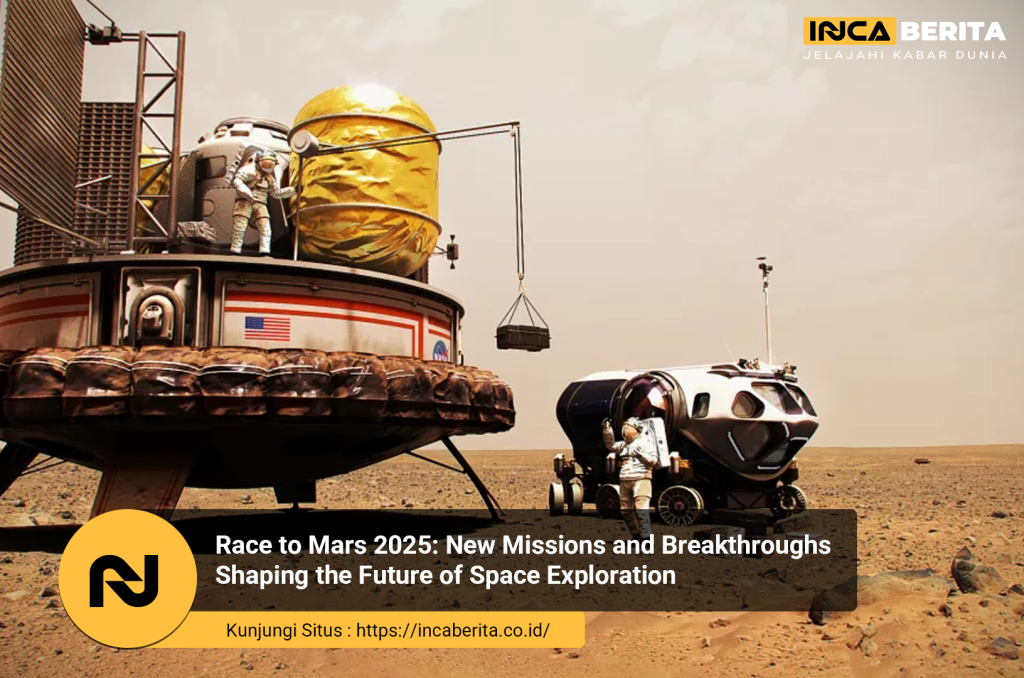Mars Exploration 2025: The Race to Mars Continues

Mars has always intrigued humanity, its mysterious surface and the possibility of life sparking curiosity and wonder. The quest to reach the Red Planet is more than just a science project—it’s an ambitious race driven by global space agencies and private companies alike. With missions planned for 2025, the race to Mars is not only about sending rovers and satellites to gather data but also preparing for the possibility of human exploration.
In this article, we’ll delve into the race to Mars in 2025, where technological advancements, new missions, and the drive for scientific discovery are shaping the future of space exploration.
Race to Mars 2025: New Missions and Breakthroughs Shaping the Future of Space Exploration
1. NASA’s Artemis Program and Mars Exploration

The Artemis program is a cornerstone of NASA’s plans for the next decade, as it sets the stage for humanity’s eventual journey to Mars. By sending astronauts to the Moon in the coming years, NASA plans to establish a sustainable presence on the Moon as a stepping stone for future missions to Mars.
By 2025, Artemis aims to send the first woman and the next man to the Moon, which will be essential for testing new technologies, conducting scientific research, and learning how to live and work on another planet. These lessons learned will be vital when preparing for longer-duration missions to Mars, which is expected to take astronauts at least six months to reach.
Artemis is designed to test new systems that will also be used for Mars missions, such as life support systems, advanced propulsion technologies, and habitat modules. The goal is to establish a sustainable base on the Moon by the end of this decade, which will serve as a platform for Mars exploration in the early 2030s.
2. SpaceX’s Starship and Mars Colonization Goals
One of the most ambitious private sector companies leading the charge in Mars exploration is SpaceX. Founded by Elon Musk, SpaceX aims to make humanity a multi-planetary species, with Mars being a key destination. Musk’s vision is to establish a human colony on Mars, and the Starship program is central to this dream.
The Starship spacecraft is being designed as a fully reusable spacecraft capable of carrying up to 100 passengers, along with cargo, to Mars. SpaceX has been testing prototypes of Starship, and by 2025, the company hopes to have made significant progress toward launching its first crewed mission to Mars. SpaceX’s Mars goal is to significantly reduce the cost of interplanetary travel, making it possible for humans to eventually establish a permanent presence on the planet.
If successful, SpaceX’s efforts could dramatically accelerate humanity’s timeline for reaching Mars and create the infrastructure needed for long-term exploration and even colonization.
Current and Upcoming Mars Missions in 2025
1. NASA’s Perseverance Rover and Ingenuity Helicopter
Since its landing on Mars in February 2021, NASA’s Perseverance rover has been on a mission to explore Mars’ surface, specifically the Jezero Crater, in search of signs of ancient life. By 2025, Perseverance will have gathered significant data on the planet’s geology, atmosphere, and the potential for life. Perseverance is also actively preparing for the first-ever sample return mission, which will collect Martian soil and rock samples to be returned to Earth in the future.
The rover’s companion, the Ingenuity helicopter, has already achieved several successful flights on Mars, marking the first time that powered flight has occurred on another planet. Ingenuity’s success paves the way for future aerial exploration, as drones and helicopters may one day be used to scout for suitable landing sites or investigate areas that rovers cannot reach.
2. Chinese Mars Missions
China’s space program has made significant strides in recent years, and its Mars exploration efforts are a key part of its growing capabilities. In 2021, China successfully landed its Tianwen-1 rover on Mars, marking a major milestone as China became the third country to land a rover on the Red Planet. By 2025, China will likely continue its exploration of Mars with more advanced missions, including potential sample return missions and ongoing studies of the Martian environment.
In addition to its rover efforts, China is reportedly planning to build a Mars research base, further fueling the race to explore and eventually colonize Mars.
3. Other Mars Missions to Look Out For
In addition to NASA and SpaceX, several other countries and private companies are planning Mars missions. The United Arab Emirates’ Hope Probe, launched in 2020, continues its mission to study Mars’ atmosphere and climate from orbit. In 2025, we may see further collaborations between space agencies, including ESA (European Space Agency) and Roscosmos (Russian Space Agency), which have announced plans to collaborate on various Mars exploration missions in the near future.
Technological Breakthroughs Driving the Race to Mars
1. Advanced Propulsion Technologies
One of the greatest challenges of Mars exploration is the long travel time involved. Current propulsion technologies, like chemical rockets, make the journey to Mars take around six to nine months. However, by 2025, there is hope that new propulsion systems will reduce travel times and make interplanetary travel more feasible.
One promising technology is nuclear thermal propulsion, which uses nuclear reactions to heat propellant, providing a more efficient method of propulsion than traditional chemical rockets. NASA is also investigating electric propulsion, which could make deep space missions more cost-effective and efficient.
2. Life Support Systems for Long-Duration Missions
Another crucial technology for Mars exploration is the development of life support systems that can sustain astronauts during long-duration space missions. These systems will need to provide oxygen, water, and food, as well as remove waste, in an environment where resources are scarce.
NASA’s Biosphere 2 experiments and other technologies are focused on creating closed-loop life support systems that can function independently for years, making long-term human presence on Mars more viable. Additionally, ISRU (In-Situ Resource Utilization) technologies are being developed to extract resources from Mars itself, such as using Martian soil to produce oxygen or water, which would reduce the need to send supplies from Earth.
The Vision for Human Colonization of Mars
1. The Challenges of Human Mars Missions
The path to human colonization of Mars is fraught with challenges, both technological and psychological. While SpaceX’s Starship and other spacecraft designs are being developed to transport people to Mars, the harsh conditions on the Red Planet—such as extreme temperatures, radiation, and low gravity—pose significant risks to human health.
To mitigate these risks, scientists are researching ways to protect astronauts from harmful radiation, such as through radiation-shielding materials or underground habitats. Moreover, new habitat technologies are being designed to provide a safe and comfortable living environment for astronauts.
2. The Long-Term Goal: Mars as a Second Home
While sending humans to Mars by the early 2030s is a major milestone, the ultimate goal is to create a sustainable human presence on the planet. This would involve constructing permanent bases, developing self-sustaining agriculture, and harnessing Martian resources to reduce dependency on Earth. A colony on Mars could pave the way for further exploration of the solar system and potentially offer humanity a backup plan in the event of Earth-facing existential threats.
Conclusion: The Race to Mars is Just Beginning
Mars exploration in 2025 marks an exciting chapter in the ongoing race to understand and reach the Red Planet. With new missions from NASA, SpaceX, China, and other players, we are closer than ever to uncovering the secrets of Mars and possibly establishing a human presence on the planet.
The breakthroughs in propulsion, life support, and technology will continue to shape the future of space exploration, making it increasingly possible to one day set foot on Mars. As humanity continues its ambitious quest to explore Mars, the next decade promises to be a thrilling one for space enthusiasts, scientists, and dreamers alike.
The race to Mars is far from over—and in 2025, we are just getting started.
Why COP28 is Crucial for Our Future – An Insightful Look
As we navigate the path toward sustainability, it’s crucial to stay informed about global efforts to combat climate change. One such effort is the COP28 conference, which brings together world leaders, activists, and experts to discuss critical environmental policies and solutions. In my recent article on [Topic of your current article], I explore how our individual efforts can align with international goals. COP28 serves as a pivotal platform for these discussions, and I highly recommend diving deeper into it for a better understanding of how global actions can make a difference.






